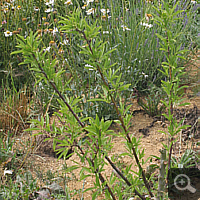Almond (Prunus dulcis)
Overview
Everyone knows the fruits of the Common Almond tree. Under good conditions you can obtain these directly from your own garden. The Common Almond tree is a member of the Rose family (Rosaceae) from Southwest Asia.
Description
The Common Almond tree is a little, deciduous tree with a maximum height of six metres. The shiny leaves are elongated, already in the early spring an Almond tree sprouts plenty white flowers, from which the drupes arise by a pollination by insects. The exterior, green shell bursts at full ripeness and releases the interior, light brown, structured shell. This encases the innermost part, the basic almond.
Culture
The tree itself is well frost-hardy. Main problem is the early blossom of the Common Almond tree in March to April. Thereby it is very vulnerable by late frost. Thus choose a variety with an as late as possible blossom. A favourable location is slightly protected between other fruit trees or in front of a house wall. Also the fruits are endangered by a cold spell and are dropped completely under adverse conditions. Concerning the composition of the ground exist rather moderate demands. A regular cut is well tolerated.
Experiences
2009
In summer 2009 I planted also a Common Almond tree.
2010
During winter it a protection by rush mats so that the frosty days were survived easily and it draped in a delicate sea of blossoms in spring. A while later it produced circa three dozen small almonds, which all were dropped unfortunately after a later cold spell though.
2011
Winter was well survived without any protection. Single branches were frozen back a few centimetres. The blossom appeared very poorly in comparison to the previous year. I could not detect a reason for this. So far, the growth keeps within limits due to the dryness.

